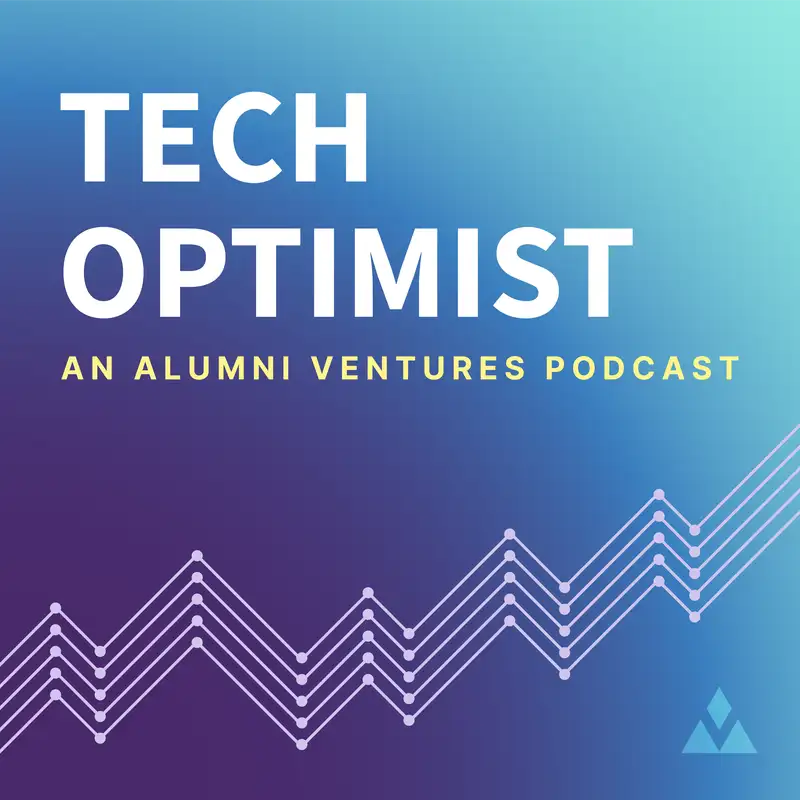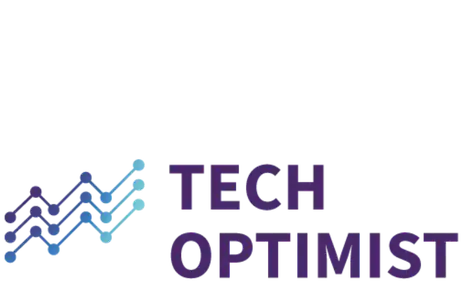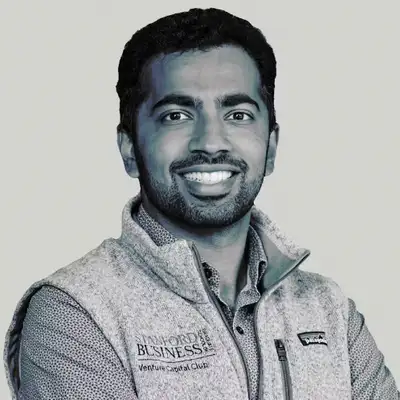#94 - 3 Big Stories in AI
Sam:
Hi, innovators and dreamers. Welcome to Tech Optimist, brought to you by Alumni Ventures. Today we're diving into not one, not two, but three jaw-dropping breakthroughs shaping the future as we speak. If you're into bold ideas, visionary founders, and tech so sharp it cuts through convention, this is your moment and this is your podcast.
Mike Collins:
Do not underestimate a founder in founder's mode going all in.
Sam:
Everyone should know of that voice at this point. This is Mike Collins, founder and CEO of Alumni Ventures.
Naren Ramaswamy:
So what are the repetitive things that we are doing every day that can be automated and can actually be maybe amplified using the help of AI?
Sam:
This is Naren Ramaswamy, senior principal at Alumni Ventures. And then that's me. My name is Sam and I am the Tech Optimist host and producer. I'm going to be providing tech notes and just my two cents here and there to help provide a little bit more context and cut through the sort of technical jargon that we're going to hear today to get everyone on the same page about what we're actually talking about.
Okay, welcome back, everyone. Today we've got a lineup of a breakthroughs that push the boundaries of what's possible, and we'll be breaking them down with our incredible guests, Mike and Naren. They had their own spotlight earlier, but they're going to have the entire episode to themselves. So I'll be chiming in along the way with some quick notes because, well, sometimes I can't help myself when it comes to tech. So here's what's on deck for the episode.
First, we're exploring three new AI models. They're redefining how machines learn, think, and create. And these aren't just updates, they are game changers that could rewire industries. Then we're going to dive into Amazon's massive investment into Anthropic, one of the most talked about AI research companies of the year. Spoiler alert, this isn't just about money. It's about building the future of AI with purpose. And finally, the wildest story of them all, AI is helping us decode the language of humpback whales. That's right, we're talking about machine learning models, diving deep into whale song to bridge the gap between species. Mind-blowing, right? So Mike and Naren are ready to unpack all of this and so much more, so let's jump in. Don't worry, I'll be here adding context and throwing in a few fun facts along the way. You know the drill. We got a disclaimer and an ad, and then we'll hand it over to Mike and Naren.
Speaker 4:
Do you have a venture capital portfolio of cutting edge startups? Without one, you could be missing out on enormous value creation and a more diversified personal portfolio. Alumni Ventures, ranked a top 20 VC firm by CB Insights, is the leading VC firm for individual investors. Believe in investing in innovation. Visit av.vc.foundation to get started.
Sam:
As a reminder, the Tech Optimist podcast is for the informational purposes only. It's not personalized advice, it's not an offer to buy or sell securities. For additional important details, please see the text description accompanying this episode.
Mike Collins:
Hey, and welcome to this week, Tech Breakthroughs, where we get together with our Alumni Ventures community and talk about things that are going on at the intersection of technology, innovation, and entrepreneurship. I'm here again with Naren and this is going to be an AI week, Naren. Just the waves keep pounding against the shore, but it's what's going on at this place in our history, so we need to talk about it. Take it away.
Naren Ramaswamy:
Yeah, it seems like the gift that keeps on giving right now, which is really exciting as VCs because we were just watching the future unfold in front of our eyes week by week. This week, Mike, I wanted to kick it off with actually three breakthroughs bundled into one to start off. There's three new AI models that I wanted to talk about just to give the audience a sense of what capabilities AI can do these days. So I'll just go through each of them and throw it back to you, Mike, to get your thoughts. The first one is there's a new computational model out of Stanford that uses large language models to simulate a society, essentially attitudes and behaviors of 1,000 individuals, and it can replicate responses to social surveys, personality tests with 85% accuracy. So you've essentially created an AI-generated world. And you can think about the applications as being, let's say you want to launch a new startup or a new, a brand of some kind. You want to get a bunch of user interviews. You're essentially creating a synthetic audience that gives you feedback and interacts with you.
This seems what caught my attention here is we've talked about the metaverse during the pandemic, but this seems like a really cool intersection of AI and the metaverse and something that's actually useful, and so that's cool. The second piece is around weather forecasting. We've looked at a few companies at the intersection of AI and weather forecasting. What's cool to see is that Google launched a weather model called GenCast, which offers a range of likely weather scenarios and basically provides probabilities for each of them. And what's even cooler is that they've open sourced this. Collaboration with weather institutes to really help us understand nature, predict the next weather event, super important and very timely.
And the last AI model, it's called a World Foundation model. Google released this one as well. It's called Genie 2. And it creates diverse 3D environments, specifically for gaming right now, but just an interactive playable world, and it just generates it from scratch. So it's just amazing that first AI was really good at understanding how we speak and read. Now it's learning more about the physical world like weather and the physics of the world around us through these game simulations and even creating personas of people in society. And so it's just fascinating to me. I'm curious to get your thoughts on the pace of innovation here.
Sam:
Okay, everyone, so now it's time to dive into the three groundbreaking AI models that are pushing the boundaries of innovation that Naren has brought to our attention today. So thanks to insights from leading research, these developments are transforming everything from virtual interactions to weather predictions and even creative 3D environments. Let's break it down. First up is Stanford's virtual society AI simulation. So this comes from a study titled Generative Agents: Interactive Simulacra of Human Behavior. Researchers created a virtual society of 25 AI agents modeled after human behavior. These agents could remember, reflect, and plan, and they lived out their lives in a simulation reminiscent of the Sims. One character ran for mayor, another hosted a Valentine's Day party, and all agents showed behavior so human-like that some observers found them more realistic than actual people. The implications, immense.
For gaming, it could revolutionize NPCs. For social science, it provides an entirely new way to study human behavior. But as highlighted by Stanford and AI experts, it raises ethical concerns around misuse, especially in creating deceptive content or sophisticated deep fakes. Learn more directly from sources like Windows Central and Stanford's HAI website to understand the full scope of this fascinating experiment. Next, GenCast by Google DeepMind. So now let's talk weather. I'm not a meteorologist, but GenCast, a powerful AI weather model, has set new standards for forecasting accuracy and speed. Developed by Google DeepMind, this model is 97% more accurate than the world's leading ENS system for extended 15-day forecasts. It can predict extreme events like cyclones and heat waves with incredible precision and does so in just eight minutes, a process that previously took supercomputers hours. This AI has massive implications for everything from renewable energy planning to emergency preparedness. GenCast's probabilistic approach, training on 40 years of historical weather data, makes it a game changer. As detailed by sources like the Smithsonian Magazine and Google DeepMind themselves, this technology could redefine how we respond to extreme weather events and plan for the future.
And lastly, Genie 2, also from DeepMind. Prepare to have your imagination stretched. Genie 2 is an AI model that generates entire interactive 3D worlds from just a single image prompt. Imagine creating playable environments in seconds from exploring ancient ruins to interacting with futuristic sci-fi spaces. This isn't just about visuals, Genie 2 incorporates physics, realistic lighting, and even character animations. Users can swim, jump, and interact with these fully fleshed out worlds. While Genie 2 isn't quite ready to produce AAA video games, it's a massive step forward for game development, rapid prototyping, and even creative exploration. For more, check out Digital Insights from TweakTown and DeepMind's own blog. So what's the big picture? These three models are just a glimpse into AI's growing capability, making life more interactive, predictable, and even creative. And as Naren dives deeper into each, I'll add a few more notes to round off this conversation. But let's hand it back to the two of them.
Mike Collins:
Yeah, well, the pace is just way beyond I think the human ability to totally process it. I think that's the bottleneck factor frankly for a lot of these things. I could just touch on a couple of points. One is the very real opportunity of simulating the physical world, I do not think can be understated. And let me just bring it home to our particular company. We now, for example, with everything we do in marketing, run it by basically a synthetic focus group consisting of AI-generated individuals and compliance experts and people who are experts on running focus group. So basically we have created a, to simplify it, think of it as a synthetic focus group that is always working, is probably better than a physical focus group from their attention span, their willingness to be constructive, the lack of domination by one voice. And for example, if we're going to generate a piece of content, to get feedback basically instantaneously about what resonates, what doesn't, what's clear, what's not, how could we change the title to make this more appealing to you. I think this is just the way all business is going to very quickly be conducted.
And it is not 5% better. It is five to 10X faster or better. And our company in 10 years has probably run three focus groups and now we have them based on all of our funds, all of the underlying personas that go into the funds. Because we have a vast array of people that find venture capital interesting and something they want to learn more about, but they're at very different parts of their journey, they have different priorities. We have a pretty good handle on those things, but our ability to now simulate those in order to do our work better, just total game changer for us. And this is again, kind of this Stanford research is really doing kind of the same thematically approach, which is can you create virtual people that become as rich as actual human beings that you can test things with, that you can model against, that you can use in all kinds of different potential use cases. Imagine dating apps, imagine things in healthcare, things in education. But it is front and center going to upend marketing for one.
Again, this idea of the new weather app, again, we have seen enormous improvements in these world physics, understanding the natural world. Weather forecasts 20 years ago were lousy. They were maybe pretty good a day in advance. Now they're pretty darn good four or five days in advance, and they're just a lot better than they used to be. And using now the combination of AI and open source I think is an incredible power. I try to, when I talk to people about AI and humans and the role of each, I kind of make the point it's two plus two equals 10, that there is 100% a role of humans in this process, but it's not two plus two equals five. If you have a system that uses the best of humans and the best of AI, and it's a collaboration between both, and that's to me what I'm hearing when we hear about open source, which is humans doing their thing and these powerful, powerful models, again, I think it's kind of the two plus two equals 10. And weather is against something that we can all relate to. I think we also all understand the incredible economic impact of weather, whether on the positive end or whether it's in agriculture or things like disaster anticipation, really, really important stuff.
And then the foundational models, the ability to take, I believe a photograph or a word description and create a world that is-
Naren Ramaswamy:
Just extrapolates.
Mike Collins:
That it just extrapolates. And there's physics and the things that I imagine if you worked at Pixar or at a gaming company that you literally had teams of people working hundreds of hours to do. Is just it's a game changer in any form of education, the applications in just storytelling, which permeates our society. My son is getting a master's at Columbia, his MFA basically in storytelling. And the ability to use a tool like this to in essence create a world, create storyboards, play with scenarios. There's actually very interesting work done by some of the top filmmakers now where they're creating... There was a documentary shown last week in New York, which basically had an infinite number of every showing of the documentary was unique. Because an AI took the components, and it wasn't just a random, oh, here are a hundred different segments that were randomly thrown together. The AI system actually created different story arcs, different points of emphasis. It was next generation taking the components and kind of building various unique movies. And again some of the-
Naren Ramaswamy:
Super cool.
Mike Collins:
Some of the edgier, more forward-thinking directors now are thinking of a movie is not, oh, you had the movie, you had the director's cut maybe, but now the story is more dynamic, I can play with more scenarios, I can see five different endings being done that all make sense, I can add more footage. This is one thing the documentarian mentioned, is they had some new things that they could throw in and that would just change the entire documentary. So this kind of the framework of world building, storytelling through the use of these technologies is amazing. So again, just an incredible pace of change and real world application. I just keep encouraging people to not think statically about this. To say, "Oh, I went and tried ChatGPT, I tried, it hallucinated, it wasn't that helpful to me in my day job," and they kind of have turned off their brain. And it's like you just got to stay with it and you got to stay open-minded. And these things are changing so quickly that one just keep trying and keep experimenting and keep having an open mind I think is super essential.
Sam:
We'll be right back after this short break.
Speaker 4:
Exceptional value creation comes from solving hard things. Alumni Ventures Deep Tech Fund is a portfolio of 20 to 30 ventures run by exceptional teams who are tackling huge opportunities in AI, space, energy, transportation, cybersecurity, and more. These game-changing ventures have strong lead venture investors and practical approaches to creating shareholder value. If you are interested in investing in the future of Deep Tech, visit av.vc/deeptech to learn more.
Mike Collins:
Topic two, like Amazon has come in with a big investment in Anthropic, which has the Claude model, which is... It seems like to me the big three are Perplexity, which is really carving out an interesting niche in kind of search, search plus, you've got obviously ChatGPT and OpenAI, which are really leading the way with reasoning models I would say, and then do not forget about Anthropic. And we internally are actually using Claude to do some of these synthetic focus groups. Works really well, really easy to set up, really smart, really powerful model, really practical results. Doing a really, really nice job there.
Sam:
All right, so now let's shift gears to a blockbuster story in the AI world. Amazon has doubled down on Anthropic, the AI startup behind the Claude family of models, with an additional $4 billion investment, bringing their total stake to a staggering $8 billion. While Amazon remains a minority shareholder, this move cements their strategic partnership. And here's why this is big. Anthropic has chosen Amazon Web Services, or AWS, as its go-to cloud provider. So this means that AWS will be powering future AI innovations using in their state-of-the-art Trainium and Inferentia chips, hardware designed specifically to accelerate AI workloads. As part of the deal, AWS customers get early access to Anthropic's latest models, tailored to their own data via Amazon Bedrock. But there's more. This collaboration isn't just about today's technology, it's about shaping what's next. Anthropic and Amazon plan to co-develop the next generation of AI hardware and enterprise-ready tools. This makes Amazon a formidable competitor to other tech giants like Microsoft with OpenAI and Google DeepMind. Now, what does this mean for the industry, you might be asking? For one, it's a signal that Amazon is playing hardball to regain ground in the AI race, and it also highlights that growing role of generative AI is enterprise-level cloud computing. So as we watch this space evolve, this is clear, this partnership is more than an investment, it's a commitment to redefining what AI can do and to redefining the future.
Mike Collins:
I have heard that Amazon, Jeff Bezos is spending, he kind of has stepped away from Amazon and I hear he's spending a lot more time back at Amazon because of AI, that they are viewing it as a very horizontal important life or death technology. And that literally, he's quoted as saying, "There's everything we do at Amazon is dramatically impacted by artificial intelligence." And so they're doing it, I think they're approaching it from an all-in perspective. This is just one vector that I suspect all of the big tech companies are all in. And if you have any doubts about how powerful this technology is, look at the investments they're making in with money and in time. And yes, you don't see what's going on when your package shows up on your doorstep during the holiday season, but trust me, the smartest, most informed, most forward-leaning people in our society are stepping back in. I think the same is also true with some of the founders of Google, that this is a generational opportunity and risk and they want to preserve their life's work and legacy where they feel that if they don't, what they've built could be at risk.
So I think what it says about a total, I think, of $8 billion now they've put into this company. Obviously this is related to kind of AWS, this is related to a lot of these companies wanting to be vertically oriented, which is they want to have their own data, they want their own chipsets, they want their own... I think Facebook last night put out an RFP for nuclear. I want to control the energy. I don't want a bottleneck somewhere else in the system. So they're putting an RFP to build, give me Facebook nuclear centers on my data centers. Those went out I think last night. So pretty incredible what America's MAG 7 is doing in this space.
Naren Ramaswamy:
I think, Mike, what's fascinating to me is that there's this theory or this notion in business about the sleepy incumbent coming from, obviously from Clayton Christensen's great work. But these companies are almost giving respect to Christensen's work and saying, listen, we're not going to fall for that. We're not sleepy and we're going to go all in. And to have Larry and Sergey come back and help Google in the way that they have, and you mentioned Jeff Bezos and Amazon, it's fascinating to see how they're sort of trying to get ahead of it and innovating at the pace of, frankly, a startup.
Mike Collins:
No, listen, I miss clay and I would love to hear his take on this because these companies are aware of his work for sure. I know all of the founders of these companies have great respect for Clay and his work, and they're like, that will not be me. And Clay, in fairness, didn't say it was predetermined, that there are these pressures, that there are these natural decision-making processes that would lead one to these bad outcomes. But it is not fait accompli. It is an... And again, you hear the term founder mode, which is basically just the power of the personality of the founder, like a Jeff Bezos, to come in and in a very strong way move an organization. Again, and we see this with some of the most successful companies, with Jensen and Elon and stuff, is that they, clearly it is teams and that they are the visible point person on their companies. But do not underestimate a founder in founders mode going all in on these kinds of existential things.
And it has worked. I mean, I think there was a good example of that, Naren, is Netflix. Netflix sold basically DVDs in the physical mail in red envelopes for a decade. And you would've claimed, oh, they'll be the sleepy old company. Look at what they did to Blockbuster. There will be now a disruptive player that will come and eat their lunch. And it wasn't easy and there was a lot of pushback, but there was an ability of Reed and the team there to kind of navigate that kind of disruptive transition to be kind of the leading streaming of movies now. So I do think we're seeing the great American tech companies rise to the occasion.
Naren Ramaswamy:
Yeah. And it's a great segue to the third point I wanted to bring up is there's news now that AI enabled a conversation with a humpback whale, 20-minute conversation with a whale off of Alaska's coast. And scientists basically created these human-generated whale contact calls and the whale responded, and for 20 minutes they had an exchange. And this is just a breakthrough in terms of communication research and understanding animals. The bigger insight for me is we've talked about startups and we've spent our days just looking at these most amazing companies revolutionizing the world based on AI. We then talked about big tech companies and what they're doing. But here comes research teams often open sourcing models for the world to use. So as VCs, we think a lot about where will value accrue. I think all three of the above is where value will accrue. I mean, it shows the foundational power of the technology. And with open source becoming more and more prevalent in AI infrastructure, it's going to be really interesting to see what comes out with big tech startups and research groups all firing on all cylinders.
Sam:
Imagine this, you're on a boat off the coast of Alaska surrounded by the crisp air and stillness of the ocean. Suddenly, a humpback whale named Twain swims up to your vessel responding to the sounds you've just broadcast underwater. What happens next? A 20-minute exchange of signals that some are calling the first conversation with a whale in its own language. This isn't science fiction. It's the work of the Whale-SETI team led by Dr. Brenda McCowan of UC Davis. Their groundbreaking October 2024 interaction with Twain was powered by cutting edge AI technology. So here's how they made it happen. The team began by broadcasting pre-recorded humpback contact calls underwater. Twain, curious and responsive, approached the boat and matched the interval patterns between the signals, almost as if engaging in a turn-taking conversational rhythm. AI algorithms captured and analyzed the exchange, showing a level of complexity that suggests whales may have their own structured communication system.
So why does this matter? Whale-SETI isn't just about chatting with marine life. It's part of a larger initiative to understand non-human intelligence. By decoding humpback communication, researchers hope to develop tools for identifying intelligence signals in the search for extraterrestrial life. It's the intersection of marine biology, AI, and astrobiology. But it's not all cosmic ambition. This work also has immediate conversation implications. Understanding whale communication can improve our ability to protect these creatures and their ecosystems, and perhaps it challenges us to reconsider how we interact with intelligent life on earth. So stay tuned as we dive deeper into this extraordinary story, and consider what it might mean for our connection to other species on this planet and beyond.
Mike Collins:
It bothers me immensely when people pooh-pooh basic research, that we don't need basic research, that, oh, look at this cute little project with humpback whales. It's like we need to be doing practical stuff that makes better cement. And what a waste of time, money, those people are goofing around. And the truth of the matter is that is an important part of the stack to this great American tech entrepreneurship venture capital system as other parts of it. In fact, arguably it's people doing work with a lot less both societal reward and economic reward, but they are pursuing base layers of understanding that make higher level work up the stack possible.
Naren Ramaswamy:
Exactly.
Mike Collins:
And so yes, we love our iPhones and before that we loved our MacBooks and our Macintoshes, but there was fundamental research done by research relating to the internet and relating coming out of deep research labs where Steve Jobs walks in and basically sees somebody who's been working on an R&D department and then commercializes it. So I appreciate you bringing up that kind of an example because I think it is just so easy to say, how does that impact my life? Or how does that, where is there a startup dealing with whales speaking to each other? But at the fundamental level, this is science and this is understanding of the world and communication. And these underlying things are what make AI possible. These models build on each other. And so it is no coincidence that a lot of our great American technology companies are rooted in academic institutions.
And I do think one of the reasons that we have been this engine of value creation as a society is that our research, we have an amazing university system, an amazing research university system. And listen, I have my complaints about our secondary education system, the colleges and universities effectively being hedge funds with an educational front end. I could talk about that. But at the end of the day, the research coming out of these places is an enormous societal benefit. And we mess with that at great peril. So I just think we always want to keep in mind, yes, the company that does an IPO is fantastic, but if you really were going back 10, 20 years to some foundational work that came out of an institution that allowed them to stand on the shoulders of other companies that stood on the shoulders of great research, let's never be so short-sighted to say we need to stop understanding first principles and science and supporting basic research, some of which, by the way, will not pan out.
Naren Ramaswamy:
Yeah. It's like a startup.
Mike Collins:
Welcome to the world we live in. Seven out of 10 startups don't make it either. Seven out of 10 research projects that don't have a great insight or add value, it's the cost of doing business. So let's understand the role of fundamental research in this system and protect it, preserve it, enhance it, make it better, but respect it.
Naren Ramaswamy:
Absolutely. And the last thing I'll say is each of us should be thinking about where pattern matching can be used to enhance our lives. Because the current AI technology is basically pattern matching. Like large language models can pattern match from a bunch of text and predict the next word. These whale scientists can predict what whales are saying. It's all a pattern. So what are the repetitive things that we are doing every day that can be automated and can actually be maybe amplified using the help of AI so that we are doing more creative thinking and things that don't make us feel like a machine, where we can actually automate some of those tasks.
Mike Collins:
It's most of our day. It's most days for most people.
Naren Ramaswamy:
Yeah. If you reflect on it-
Mike Collins:
Unless you're doing physical work, the majority of your day, most of what you're doing is manipulating symbols and patterns.
Naren Ramaswamy:
Yep.
Mike Collins:
So it's a big part of our existence as humans.
Naren Ramaswamy:
Exactly.
Mike Collins:
So super exciting. I know you're coming this way. Look forward to seeing you. And we'll do it again next week. Thank you, Naren.
Naren Ramaswamy:
Likewise. Thanks, Mike.
Sam:
Thanks again for tuning into the Tech Optimist. If you enjoyed this episode, we'd really appreciate it if you'd give us a rating on whichever podcast app you're using, and remember to subscribe to keep up with each episode. The Tech Optimist welcomes any questions, comments, or segment suggestions. So please email us at info@techoptimist.vc with any of those and be sure to visit our website at av.vc. As always, keep building.







